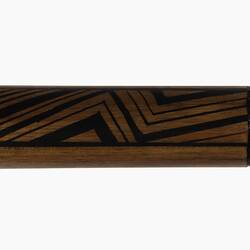Summary
This Message stick was made by Ben Church who is from the Kerrupjmara clan of Lake Condah, south west Victoria, and is one of three commissioned to replace three 19th century message sticks from Lake Condah on Gunditjmara Country that had been held at Museums Victoria for nearly a century, and have now been repatriated back to the Community. The timber for the message stick was sourced by Ben from Lake Condah in 2021, continuing the many thousands of years of cultural practice of making message sticks and reviving this in contemporary ways. Pre-contact a message stick would have been carved with a sharp and durable stone tool and or mussel shell but today Ben etched both sides with a Dremel engraver and an electronic burner. An archival ink paint pen was used for the artwork, and it was sealed with a mix of linseed oil and mineral turpentine. Contemporary Cultural practice is important to the ongoing and thriving living culture of First Peoples of Victoria, the message stick from Ben speaks to the history of his Ancestors and communicates the message to us today of the cultural strength of the Kerrupjmara people that continues and that many future generations of First Peoples will learn from and connect to.
Q&A Between Ben Church and Senior Curator Kimberley Moulton, August 2022
When did you start to revive the practices of your Ancestors? "I have worked with wood since I was a teenager, and started with the tool and weaponry production in my early 20s with the guidance from a few of my uncles - particularly my Uncle Wayne 'Swisha' Bell. Around this time we were making didgeridoos and boomernangs etc, it was from here my passion for woodwork and reproduction of Gunditjmara cultural objects really began. Over the past ten years I have been focussing more on making tools and weapons that replicate those from my ancestors."
What do these message sticks mean to you? "To be able to reproduce these message sticks is a great honour, and I feel very blessed to be able to walk in the footsteps of the Ancestors."
What is your favourite Cultural material to make? "My favourite tools to make are the ceremonial boomerangs. These traditionally were utilised for multiple reasons- for hunting, fighting and for song and dance or ceremony. I enjoy the challenge they pose during the production process."
Do you collect wood from certain sites depending on what you are making? "I collect the different timbers from different parts of Gunditjmara Country, depending on what item I am producing, or by what the request is."
What would you like the public to know about these message sticks? "These message sticks reflect a connection to Gunditjmara culture, Ancestors and Country. I believe they also highlight the importance of maintaining a continuing connection by keeping our traditional stories and practices alive and thriving."
Physical Description
Blackwood (Acacia melanoxylon). Etched both with a Dremel engraver and utilised a burner as well. Archival ink paint pen for the artwork, and sealed with a 50:50 mix of linseed oil and mineral turpentine.
Significance
Message Sticks have been a way of communicating through iconography and design by First Peoples of Victoria for many thousands of years.
They were diverse across the state, some clans used highly detailed intricate designs on elongated pieces of worked timber, and others used more simple pieces of wood or other forms of objects such as clubs or bullroarers to communicate a message for specific ceremonial reasons. The knowledge of Message Sticks have stayed in community for thousands of generations and this practice is contined today. Along with First Peoples knowledges there are some settler accounts of the making and use from early historical archives. In his 1889 article titled 'Notes on Australian Message Sticks and Messengers' anthropologist A.W Howitt describes these objects as 'emblematic tokens' and 'objects with certain gestures that when presented, represent a message and can communicate more than the spoken word'.
Message sticks and other cultural materials with meaning were carried by the messenger, who was a certain member of the clan and given this role to cross their traditional country to others country to share the message, perhaps to come together for funerary reasons, marriage, for conflict resolution, for sporting competitions and for large ceremonial gatherings. The carved message stick or cultural material that signified the type of gathering often was also made clear by the messenger speaking the name of a familiar gathering site and sometimes indicating the time or day to meet by the moon cycle. The Woiwurrung leader and Ngurungeta (head man) William Barak was recorded by Howitt talking about how a message stick may work from the Wurundjeri perspective stating "suppose being Ngurungeta I desired to call the people from all round to come for a corrobboree and for ball playing, I should, after I had talked with my friends, say to one of the young men, you go to 'such and such' people and take this Kalk (message stick) and give it to the Ngurungeta there and tell him this message. The men then going would hand my Kalk to the headman there and would give him my message, who would then show it to his men and repeat my message to them".
Message sticks are common across the country and there are only a handful of 19th century message sticks in collections across the world from Victoria including places such as Museums
More Information
-
Object/Medium
Message stick
-
Maker
-
Cultural Groups
-
Locality
-
Date Produced
-
Object Dimensions
280 mm (Length), 60 mm (Circumference)
-
Type of item
-
Discipline
-
Category





